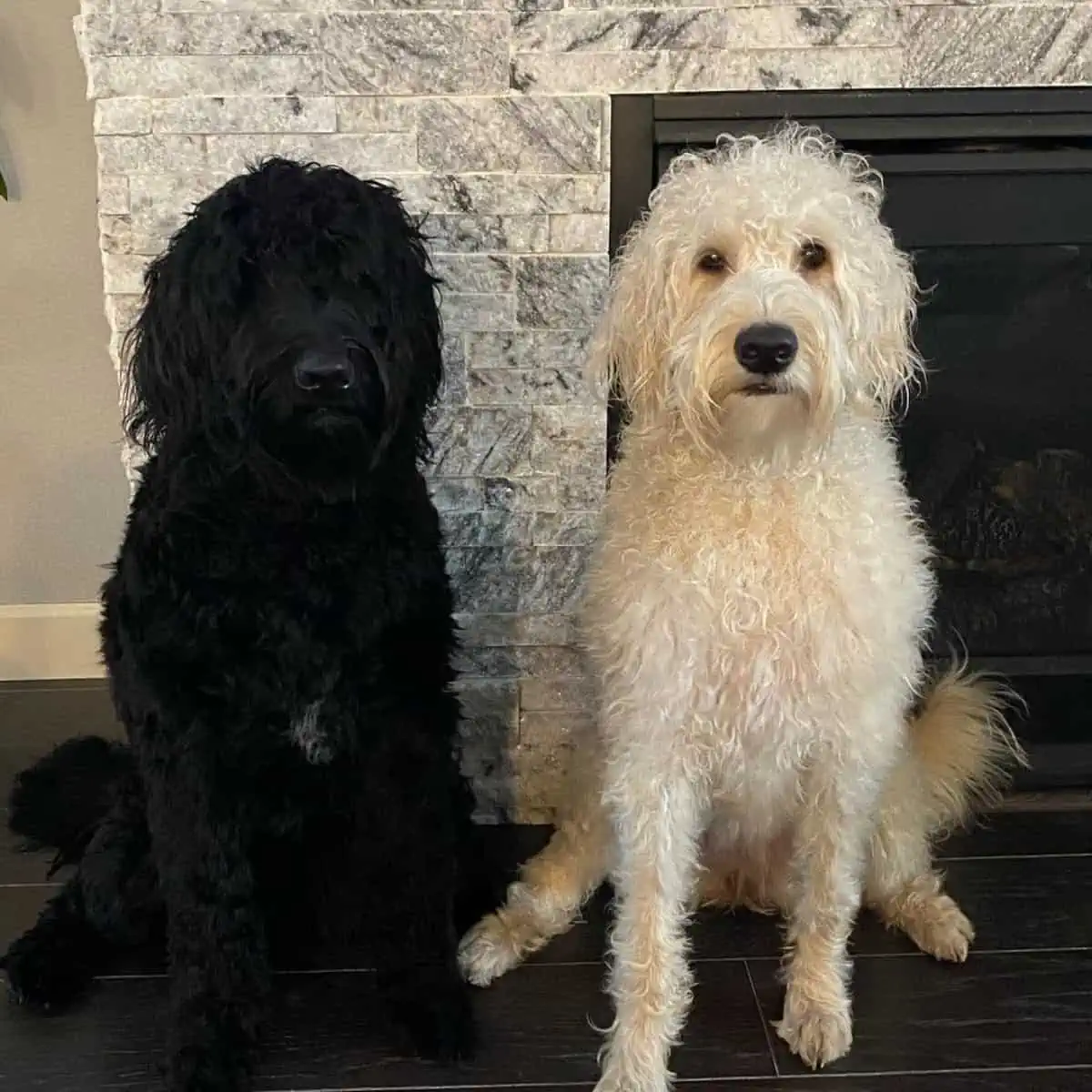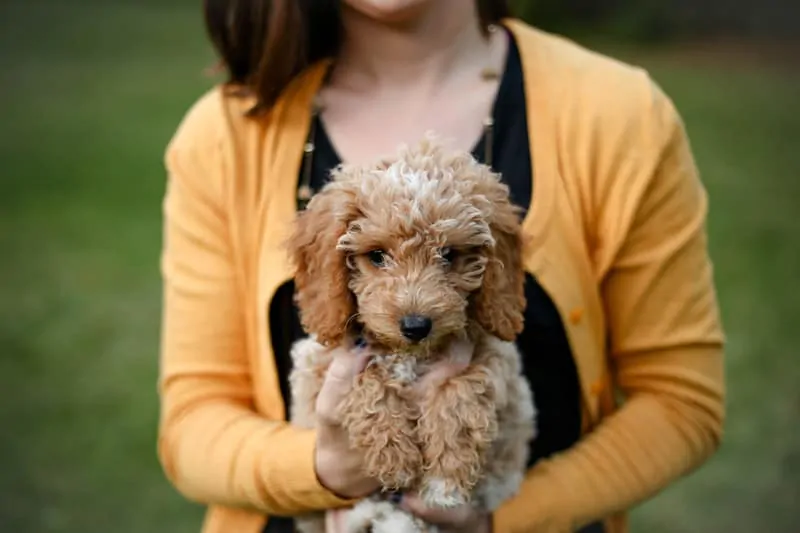When Do Goldendoodles Go Into Heat? [Statistics]
Goldendoodles have been around since the 1990s, and they’re wildly popular for a good reason. These mixed-breed dogs combine the look and temperament of the Poodle and Golden Retriever breeds. They are intelligent, friendly, and wonderfully loyal. In other words, they are ideal family dogs.
If you have a female Goldendoodle and are thinking about keeping her intact (non-spayed), you need information on her estrus (also called heat) cycles.
When Do Goldendoodles Go into Heat?
A female dog will usually first go into heat when they are about six months old. This is when they enter sexual maturity. While this varies by breed, Goldendoodles tend to follow this pattern.

If you have a smaller type of Goldendoodle (for example, a miniature Goldendoodle), she may reach sexual maturity a little earlier. This is because smaller dogs often start experiencing estrus earlier than larger dogs. Huge dogs (such as Great Danes) take longer to reach sexual maturity.
In general, the larger the dog breed, the longer it may take to start having estrus.
How Often Do Goldendoodles Go into Heat?
Your Goldendoodle female will go into heat twice each year. This is approximately once every six months. Each period of heat generally lasts between two weeks and a month. Tiny dogs (such as miniature varieties) often experience heat more often, perhaps once every four months. Heat cycles may vary between individual dogs.

Signs Your Goldendoodle Is in Heat
One early indication that your Goldendoodle is in heat is engorgement (swelling) of the vulva. This swelling may not be easily visible. You may notice a bloody vaginal discharge before you see the swelling.

The discharge sometimes doesn’t appear until several days following the beginning of estrus. When the bloody discharge first occurs, it will be very red. As the heat period progresses, it will become thinner, more watery, and more of a pinkish (as opposed to pure red) shade. As your dog will probably lick the area during grooming, you may not even notice some of the bleeding.
Your female Goldendoodle may urinate more often than she usually does. She may also show marking behavior. There will be specific hormones and pheromones in the urine at this time in your dog’s estrus cycle. Male dogs can smell this from long distances, and they will be attracted to it.
You may see certain behavioral changes when your Goldendoodle is in heat. Examples include:
- Nervousness or fidgeting
- Moving tail over to one side
- Seems to be looking for male dogs
- Lifting of the rump area
- Aggression, in some cases
- Frequent cleaning (licking) of the genital area
Stages of the Heat Cycle in Your Goldendoodle
There are four stages of your dog’s estrus cycle. These are called the proestrus, estrus, diestrus, and anestrus stages. Each of these stages is linked to specific hormonal changes and clinical (or physical) changes, as well as vaginal smear (or cytologic) changes.

While your dog will go through all these phases, each individual animal will have their own variations. In other words, there may be differences between your own Goldendoodle’s cycle and mine. For example, there may be slight differences in the type and degree of physical and behavioral changes.
Let’s take a look at the four stages of the dog heat cycle in-depth:
Proestrus
Proestrus is the first stage of heat. This is when you will probably start seeing signs of estrus in your dog. Proestrus usually lasts for about nine days. It can be much longer in some cases, though. The range extends from zero to 27 days. While your dog won’t yet be receptive to males, the males will be attracted to them during this phase. You may notice that your dog’s vulva is swollen.
Estrus
Your dog will be receptive to male dogs during the estrus phase. This stage may last anywhere from four to 24 days, but the average is nine. The time during which your dog is fertile takes place during estrus. The discharge has less blood in it, and vulva enlargement decreases a bit. There is a progressive decrease in estrogen levels and an increase in progesterone levels.
Diestrus
During diestrus, your dog stops being receptive to males. This stage is long in direction, stretching to approximately two months. Between three weeks and a month after diestrus begins, there is a peak in progesterone. After that, this hormone falls until it eventually gets to basal levels. This will be at the conclusion of diestrus.
Anestrus
Anestrus occurs after diestrus and before proestrus. Your dog will be in this stage for approximately four months. There won’t be any vaginal discharge, and the vulva is normal. Your dog’s uterus needs this time to get ready for a potential pregnancy during the subsequent estrus.
How to Care for Your Goldendoodle in Heat ?
There are things you can do to take proper care of your Goldendoodle in heat. Taking your dog for more walks can help her feel calmer. Be aware, though, that male dogs will be attracted to your Goldendoodle. Don’t go for walks in areas where you think this could be an issue.

If you want to avoid your Goldendoodle getting pregnant, you must keep her away from non-neutered male dogs. When your Goldendoodle is in heat and is bleeding, you can use doggie diapers. This will help to avoid the blood making a mess in your house. If you don’t want to use doggie diapers, you can make a bed of old towels for your dog to sleep in.
An alternative is to restrict your dog to certain areas of the house when she is bleeding. If you do this, keep the dog in places that are easier to clean (for example, that have hard flooring instead of carpeting). Of course, this tactic will only work if you have a larger house. You shouldn’t restrict your dog to an overly small space.
Should Your Goldendoodle in Heat Breed?
Experts say you shouldn’t breed female dogs during their first few estrus periods, as they are too young. There are often significant problems when female dogs produce too early. This includes not just potential physical problems but also behavioral ones. Overly young canine mothers are more likely to neglect their puppies. This can even result in a dangerous situation.

If your female Goldendoodle has not yet had at least three heats, she is too young to breed. You should be especially careful to keep her away from non-neutered males. If your dog is old enough to produce and you want her to have puppies, you should think carefully and do your research before deciding.
If your Goldendoodle breeds, you will end up with a litter of puppies. Litter sizes vary, but it will probably include at least three puppies. There may even be as many as eight. Finding homes for every pup is a time-consuming process and must be done responsibly. Puppies must stay with the mother for a minimum of eight to ten weeks.
How to Stop Your Goldendoodle from Going into Heat?
The only way to stop your female Goldendoodle from going into heat is to have a vet spay her. Of course, a spayed dog can never have puppies and will not be a breeding dog. Spaying is the process during which the vet will remove your dog’s ovaries and uterus. Most vets recommend spaying all pets when the owner doesn’t specifically plan to breed them.
Spaying, of course, is done when the animal is under general anesthesia. There are benefits to spaying that go beyond just preventing breeding. When a dog is spayed, it will be free of any risk of uterine and ovarian cancer, as well as pyometra. Pyometra is a severe infection of the uterus that can be deadly.
Of course, spaying also means that your pet will no longer have to go through two periods of heat every year. This makes life easier for them and you. You won’t have to help them deal with heat symptoms, and there won’t be a potential mess (from bloody discharge) around the house, meaning no more doggy diapers or having to keep your Goldendoodle away from non-neutered male dogs.
Pet owners often find that spayed, and neutered dogs are calmer and happier. They also tend to live longer – and have some lower health issues as an older dog. As with any procedures, however, there may be certain risks. Consult with your veterinarian to find out the details.
You should also ask your veterinarian about the best time to spay your Goldendoodle. While some vets recommend spaying before the first heat, others feel you should wait until after. If you wait until after, remember to take all the necessary steps to avoid unwanted pregnancy and be aware of the canine heat cycle. The most important of these is keeping your Goldendoodle away from non-neutered males.
The time to spay a female dog will be very different than when you neuter a male Goldendoodle. If you have two siblings – the male dog will likely have a different procedure date than your female Goldendoodle.
Enjoy Life with Your Goldendoodle
Understanding your dog’s breed is always vital in knowing how to take care of her. Now you have all the information you need about your Goldendoodle’s heat cycles. It is part of our respnsiblity at pet parents. You now know when your Goldendoodle will experience estrus, how to recognize it, how to take care of your dog during these times, and what to do if you don’t want your dog to have estrus.